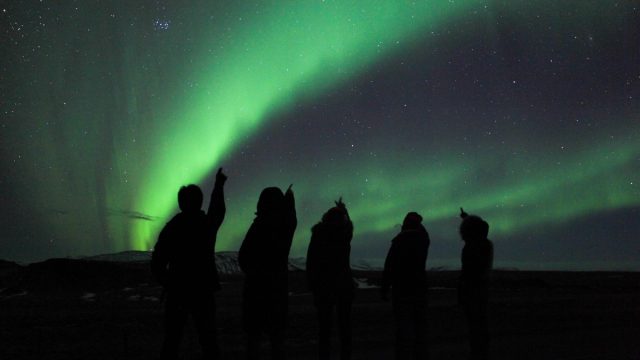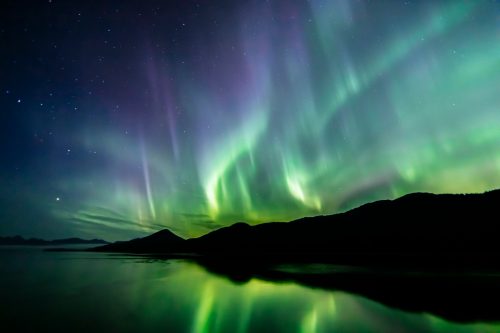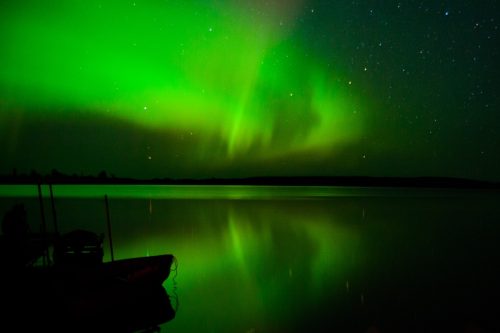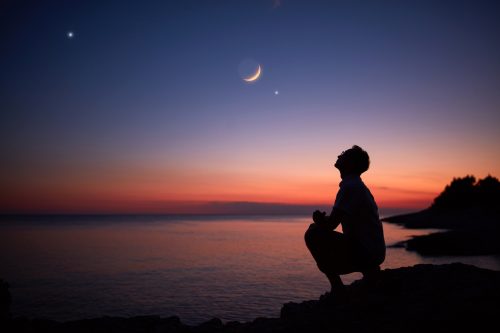“Highly Visible” Northern Lights Could Appear Over the U.S. Tonight—How to See Them

When you think about the northern lights, you conjure images of spectacular, colorful displays—which you may assume you can’t see unless you travel far north. However, these lights (also known as aurora borealis) sometimes appear above different parts of the U.S., meaning you can check an item off your bucket list without even leaving home. The northern lights are doing just that this week, as scientists say “highly visible” displays are making an appearance. Read on to find out how you can see them.
RELATED: A Special Solar Eclipse Will Create a “Ring of Fire” in the U.S.—Here’s How to See It.
Amazing light shows were reported last night.

On Monday night, residents in the Midwestern and Western parts of the U.S. (as well as parts of Canada and the U.K.) were treated to aurora borealis showings, according to The New York Times. People reported seeing purple and green “blotches” light up the night sky, while others saw more red and purple “pillars or curtains.”
The pillars and curtains are those that “start dancing and moving around, that can be more fun to watch,” Grant Hicks, a meteorologist at the National Weather Service in Glasgow, Montana, told the NYT.
The Space Weather Prediction Center, part of the National Oceanic and Atmospheric Administration, first predicted a “moderate” geomagnetic storm for Monday night into Tuesday. However, this morning it also reported “strong” geomagnetic activity, meaning the lights could be seen even farther south, per the NYT.
RELATED: 8 Amazing Things You Can See in the Night Sky Without a Telescope.
They were visible with the naked eye.

While you often need a camera to see the light displays, in eastern Missouri last night, part-time photographer Tyler Schlitt said that the lights were “highly visible” with just the naked eye.
“Some people will mistake it as clouds or something,” Schlitt told the NYT. “But if you have a good aurora show, you’ll likely see the aurora.”
Indiana resident Tia Justice told WANE that with the naked eye, “…[Y]ou could see the horizon lit up almost turquoise with brighter hints of red. It would flare brighter and get softer. Almost looks like right before dawn as far as brightness, it glows like that. The red pillaring was brightest.”
Justice added that the lights were flaring overhead for several hours, with the most intense showing at 11:45 p.m. from where she was watching in Pleasant Lake, Indiana. For comparison, Schlitt noted that on Monday night, the red pillars he spotted faded by around 11 p.m. from where he was in Missouri.
RELATED: New Green Comet Will Be Clearly Visible at Night—Here’s How to See It.
Several other states saw a show as well.
In northern Minnesota, residents shared photos of fantastic green light displays on social media, but residents even farther south were also treated to a showing.
Residents in Pennsylvania reported that the red and green hues were present, and in Virginia, the lights appeared more red and yellow.
RELATED: 6 Stargazing Secrets, According to Astronomy Experts.
There may still be time to see the northern lights tonight.

While the show on Monday night was truly a sight to behold, according to an aurora forecast from the University of Alaska Fairbanks Geophysical Institute, activity will still be “high” today and “active” tomorrow.
The northern lights can be hard to predict, but in an email sent to the NYT at 2 a.m. Eastern Standard Time (EST) this morning, William Murtagh, program coordinator at the Space Weather Prediction Center, said that while the worst disturbance has likely passed, you may still be able to see the aurora borealis with the naked eye in some northern U.S. states. However, he did not specify which states could still be in luck.
Lt. Bryan R. Brasher, project manager at the Space Weather Prediction Center, also told the outlet that “unsettled to active levels of geomagnetic activity,” might continue into Wednesday. But while the lights were visible fairly far south on Monday night, that probably won’t be the case on Tuesday night.
RELATED: For more up-to-date information, sign up for our daily newsletter.